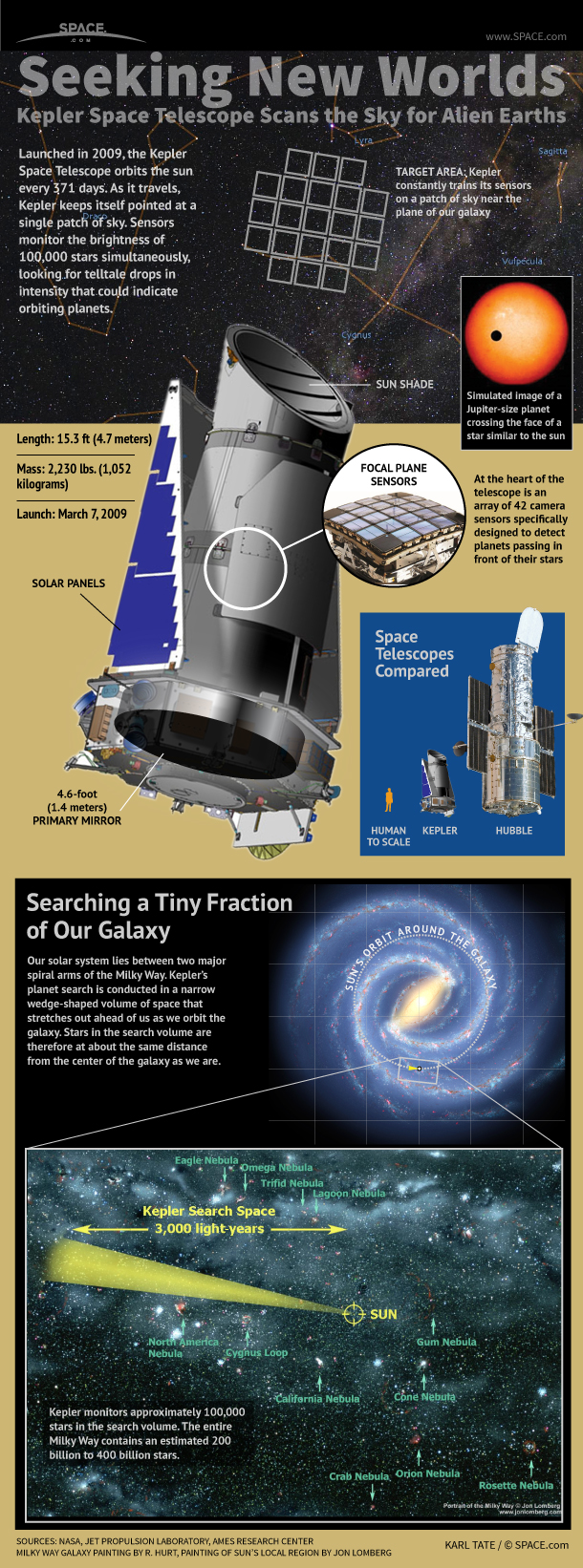NASA's Planet-Hunting Kepler Telescope Explained (Infographic)

The mission of NASA's Kepler Space Telescope is to identify and characterize Earth-size planets in the habitable zones of nearby stars. Data returned by the telescope will allow scientists to estimate the number and sizes of planets in alien solar systems, and help identify the types of stars that could harbor planets.
Launched in 2009, Kepler orbits the sun every 371 days. As it travels, Kepler keeps itself pointed at a single patch of sky. Sensors monitor the brightness of more than 150,000 stars simultaneously, looking for telltale drops in intensity that could indicate orbiting planets.
The telescope is 15.3 feet long (4.7 meters) and weighed 2,230 pounds (1,052 kilograms) on Earth. A United Launch Alliance Delta II rocket launched Kepler on March 7, 2009.
At the heart of the telescope is an array of 42 camera sensors specifically designed to detect alien planets passing in front of their stars.
Our solar system lies between two major spiral arms of the Milky Way. Kepler’s planet search is conducted in a narrow wedge-shaped volume of space that stretches out ahead of us as we orbit the galaxy. Stars in the search volume are therefore at about the same distance from the center of the galaxy as we are.
Kepler monitors more than 150,000 stars in the constellations Cygnus and Lyra. The entire Milky Way contains an estimated 200 billion to 400 billion stars.
As of September 2012, Kepler had flagged more than 2,300 planet candidates. The vast majority still need to be confirmed by follow-up observations, but mission scientists have said they expect at least 80 percent of the telescope's finds to end up being the real deal.
Kepler Reveals Lots of Planets: Some Habitable? | Video
A Galaxy Full of Alien Planets (Infographic)
Join our Space Forums to keep talking space on the latest missions, night sky and more! And if you have a news tip, correction or comment, let us know at: community@space.com.
Get the Space.com Newsletter
Breaking space news, the latest updates on rocket launches, skywatching events and more!

Karl's association with Space.com goes back to 2000, when he was hired to produce interactive Flash graphics. From 2010 to 2016, Karl worked as an infographics specialist across all editorial properties of Purch (formerly known as TechMediaNetwork). Before joining Space.com, Karl spent 11 years at the New York headquarters of The Associated Press, creating news graphics for use around the world in newspapers and on the web. He has a degree in graphic design from Louisiana State University and now works as a freelance graphic designer in New York City.
